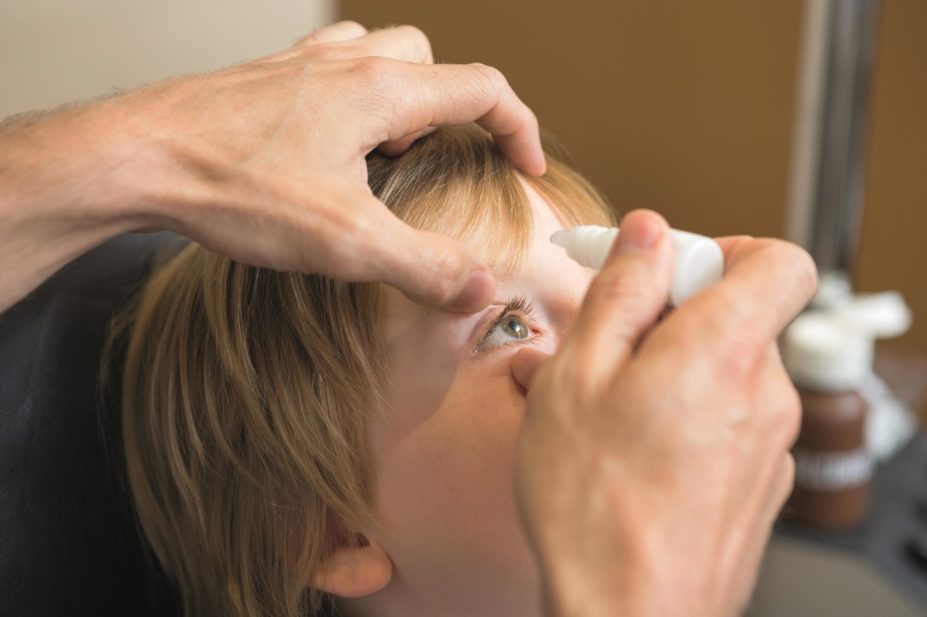
Shutterstock.com
In this article you will learn:
- The pathophysiology of dry eye disease and associated risk factors
- How to manage dry eye disease, including the available treatments
- How to select the most appropriate treatment formulation for dry eye disease
Dry eye disease, or dry eye syndrome, is a common, yet frequently under-recognised, clinical condition that can significantly impact a patient’s quality of life. It has been defined as a “multifactorial disease of tears and ocular surface that results in symptoms of discomfort, visual disturbances, and tear film instability, with potential damage to the ocular surface. It is accompanied by increased osmolarity of the tear film and inflammation of the ocular surface”[1]
.
Dry eye disease affects 17% of the US population[2]
. It is more common in older people (15–33% in patients aged over 65 years) and women are 50% more likely to be affected than men[3]
; in one UK cohort of 3,824 women aged 20–87 years, 9.6% had been diagnosed with dry eye disease and used artificial tears, and 20.8% had experienced dry eye disease symptoms in the past three months[4]
. Other factors that can increase the risk of dry eye disease include some drugs and drug groups, such as antihistamines, connective tissue disease and diabetes (see ‘Risk factors for dry eye disease’).
| Risk factors for dry eye disease | ||
|---|---|---|
| Source: American Academy of Ophthalmology[2] | ||
| Level of evidence | ||
| Mostly consistent | Suggestive | Unclear |
| Older age Female gender Postmenopausal oestrogen therapy Low dietary intake of omega-3 fatty acid Medication (antihistamines) Connective tissue disease Lasik and refractive excimer laser surgery Radiation therapy Haematopoietic stem cell transplantation Vitamin A deficiency Hepatitis C Androgen deficiency | Asian ethnicity Medication (beta-blockers, diuretics, isotretinoin, selective serotonin reuptake inhibitors and tricyclic antidepressants) Diabetes mellitus Human immunodeficiency virus/human T lymphotropic virus infection Systemic chemotherapy Large incision extracapsular cataract extraction and penetrating keratoplasty Low humidity environments Sarcoidosis Ovarian dysfunction | Cigarette smoking Hispanic ethnicity Medication (anticholinergics, antipsychotics, anxiolytics) Alcohol use Menopause Botulinum toxin injection Acne Gout Oral contraceptives Pregnancy |
Evidence-based diagnosis and treatment of dry eye disease is challenging as there is poor correlation between signs and symptoms, and the efficacy criteria are not uniform. In addition, the definitive work on dry eye disease is the Dry Eye Workshop (DEWS) guidelines, which is a consensus of international experts rather than being based on robust clinical studies[1]
.
Pathophysiology
Dry eye is recognised as a disturbance of the lacrimal functional unit, which is an integrated system comprising the:
- lacrimal glands;
- ocular surface (cornea, conjunctiva and meibomian glands);
- lids;
- sensory and motor nerves that control the blink reflex.
The tear film is composed of four layers, if including the microvilli on the corneal epithelium. The outer lipid layer is produced by the meibomian gland, which reduces evaporation. The middle aqueous layer (98% water) is produced by the lacrimal gland and also contains immunoglobulins, electrolytes and epidermal growth factors. The inner layer is mucin consisting of a sponge-like meshwork of fluid and glycoprotein molecules produced by goblet cells[1],[5]
. Damage to any part of this system can affect tear stability and lead to dry eyes.
The main symptoms present as intermittent blurred vision and a dry gritty sensation in the eye. Additional symptoms can include burning or itching in the eyes, excessive tearing, pain and redness, and in some instances, a stringy discharge[6]
. Most cases are mild but occasionally in severe cases, it can cause corneal ulceration and loss of sight.
Dry eyes can be caused by the environment, deficient tear production and increased evaporative loss. Environmental causes include dry environments and prolonged exposure to visual display units (reduced blink rate). Decreased tear production can be caused by Sjögren syndrome (an autoimmune disease in which T cells target and cause cell death in lacrimal glands), old age, duct obstruction, reflex hyposecretion (associated with diabetes) and some medication[1],[5]
. The main classes implicated include those with anticholinergic activity (e.g. antihistamines, tricyclic antidepressants and antipsychotics), those with an anti-androgen activity (e.g. prostate cancer treatments, diuretics, beta blockers) and isotretinoin.
The main cause of evaporative dry eye is dysfunction of the meibomian gland either caused by a blockage (e.g. acne rosacea, seborrheoic and atopic dermatitis) or a result of bacterial colonisation of the eyelids causing breakdown of the lipid layer. Retinoid or vitamin A deficiency and chemical burns also increase evaporative loss[1],[5]
.
Deficient tear production and increased evaporative loss can act in isolation but there is usually significant overlap[1],[7]
. Hyperosmolarity of tears and ocular surface epithelial cells stimulates a cascade of inflammatory agents, such as cytokines, which leads to apoptosis of the surface epithelial cells, including goblet cells. These inflammatory cytokines lead to further hyperosmolarity and a self-reinforcing cycle[1],[8]
.
Androgen deficiency is associated with dry eyes and there is extensive evidence that supports a role for the sex hormones in the promotion of lacrimal and meibomian gland function[1]
.
Dry eyes can, conversely, cause hypersecretion because of reflex lacrimal gland compensation. However, the tear film produced is unstable and does not resolve the discomfort, so these patients can also benefit from lubricants[1],[9]
.
Management
A classification based on the severity of dry eye disease (from 1 mild to 4 severe) and suggested treatment has been developed by DEWS[1]
and a Delphi panel of experts on dysfunctional tear syndrome[7]
(see ‘Severity and treatment of dry eye’).
| Severity and treatment of dry eye | |||
|---|---|---|---|
| Source: combination of Dry Eye Workshop (DEWS)[1] and Delphi panel’s[7] recommendations *Schirmer score – measures how far tears move up a filter paper placed in the eye. | |||
| Severity | Symptoms | Signs | Treatment |
| 1 (mild) | Mild and/or episodic discomfort under environmental stress. No visual symptoms or episodic fatigue. | Variable fluorescein tear break-up time and Schirmer* score. No, or mild, staining of cornea and conjunctiva. | Patient education and environmental/dietary modifications. Elimination of offending systemic medications. Artificial tear substitutes (preserved) eye lid therapy. |
| 2 | Moderate episodic or chronic with, or without, stress. Visual symptoms annoying and/or episodic activity limiting. | Variable conjunctival and corneal staining. Mild debris and reduced tear meniscus. Tear break-up time ≤10 secs. Schirmer* score ≤10mm. | Unpreserved tears and night time ointment/gels. If inflammation present, add in topical steroids, and/or ciclosporin A. Tetracyclines if lid disease (e.g. meibomianitis or rosacea). Secretagogues and nutritional supplements (flaxseed oil). |
| 3 | Severe frequent symptoms or chronic symptoms without environmental stress. Annoying chronic visual symptoms and/or constantly limiting activity. | Moderate to marked conjunctival staining. Marked corneal staining. Filamentary keratitis with mucus clumping and increased tear debris. Frequent lid disease (e.g. meibomianitis or rosacea) present. Tear break-up time ≤10 secs. Schirmer* score ≤5mm. | Autologous serum eye drops. Permanent punctal plugs after inflammation controlled. Contact lenses. |
| 4 (severe) | Constant and possibly disabling symptoms. | Marked conjunctival staining with severe punctate corneal erosion. Filamentary keratitis with mucus clumping increased tear debris and ulceration. Trichiasis (ingrowing eyelashes), keratisation of the eyelid and adhesion of the eyelid to the eyeball. Immediate tear break-up time. Schirmer* score ≤2mm. | Systemic anti-inflammatory agents. Surgery. Acetylcysteine. Moisture goggles (Dry Eye Workshop suggest using these earlier than the Delphi panel). |
Underlying causes (e.g. blepharitis or lid deformity) should be treated first, followed by patient education since the condition can usually be managed with good patient motivation even though it cannot be cured. If possible, the environment should be altered (e.g. by increasing humidity and taking frequent breaks away from visual display units) and suitable alternatives to drugs likely to aggravate dry eyes identified[1],[7]
.
The main objective is to improve the patient’s comfort and quality of life and to return the ocular surface and film to the normal homoeostatic state[1]
. As symptoms and signs do not always correlate, it is important to treat the symptoms[2]
.
Lubricant treatment
Although lubricants can improve the quality of a patient’s life, their exact mode of action is unknown. Most clinical studies fail to demonstrate significant correlation between symptoms and clinical tests[1]
and there is a lack of large scale, masked, comparative clinical trials to evaluate the wide variety of ocular lubricants[7]
.
The single most critical advance in the treatment of dry eyes is the elimination of preservatives. Benzalkonium chloride (BAK), the most common preservative used in eye drops, can damage the ocular surface of the eye producing conjunctival inflammation, tear film instability, corneal cytotoxicity and a decrease in the density of goblet cells and mucus production. Intermittent use of preserved drops in healthy eyes is unlikely to be a problem. However, in patients with moderate to severe dry eyes with little fluid to dilute the preservative, or requiring frequent administration of eye drops (six or more times a day), preservative-free products should be used[10]
.
Single-dose application units can be expensive and difficult to use, and so several multi-dose preservative-free devices have been developed. These include the ABAK system, the Aptar Ophthalmic Squeeze Dispenser (0.2 micron filters), and the COMOD system (one-way valve and collapsible bag). There are also “gentle” preservatives (e.g. Purite, SofZia and sodium perborate), which degrade on exposure to tears, although even these can cause some irritation in patients with severe disease[1],[11]
,[12]
,[13]
,[14]
.
There is an abundance of choice of products with more than 50 eye-drop lubricants listed in the Drug Tariff plus licensed medicines. The main differences between them are the presence or absence of preservatives, viscosity, tonicity and the presence of electrolytes and oils. The latter is claimed to be of benefit in restoring the lipid layer of the tear film. See ‘Lubricants listed in Drug Tariff and BNF’ in attached PDF.
Lubricants should be either isotonic or hypotonic. Potassium and bicarbonate ions have been shown to be beneficial in animal models, with the latter important for maintaining the mucus layer of the tear film[1]
.
The higher the viscosity of the lubricant the longer its residence time in the eye, but the more likely it is to produce blurring. There is usually a compromise with the higher viscous products being used in more severe disease, and at night[1]
.
The main lubricants used in eye drops are the carbomers (polyacrylic acid), cellulose esters, dextran and polyvinyl alcohol. Hydroxypropyl guar is a gellable lubricant that is liquid with a pH of 7 but forms a soft gel when exposed to the pH of 7.5. It then interacts with divalent ions in the tear film producing stronger crosslinking[5]
.
Sodium hyaluronate is a viscoelastic agent that lubricates as well as protects the ocular surface, and has a significantly longer ocular residence time than hydroxylpropyl methylcellulose (HPMC). It is found in the vitreous and the aqueous humour in the eye and its concentration increases in response to ocular damage and during corneal wound healing. Therefore, it may play a part in controlling the localised inflammation, but this has not been proved in clinical studies[1],[5]
.
Allergy and intolerance to preservatives and ingredients in lubricants are the main contraindications. Patients with contact lenses should wait 15 minutes between applying the lubricant and inserting their contact lenses. There is a lot of inter-patient variation between the available lubricants and treatment therefore relies on finding which one suits which patient.
Corticosteroids, ciclosporin and other anti-inflammatory agents
Dry eyes can have a significant inflammatory component and topical corticosteroids have been effective in controlling signs and symptoms, but due to their side effect profile, their use is recommended for no longer than two weeks. Topical non-steroidal anti-inflammatory agents have also been used[1]
.
Ciclosporin is an anti-inflammatory agent due to its ability to inhibit interleukin-2 activation of lymphocytes. It has very few side effects associated with use for dry eyes; mainly ocular burning, foreign body sensation, ocular hyperaemia, and ocular blurring. A recent meta-analysis concluded that patients treated with topical ciclosporin, regardless of the dose and treatment regimen, demonstrated greater improvement in the manifestation of dry eye compared with placebo. A licensed ciclosporin 1mg/mL eye drop emulsion was launched in July 2015 and is the subject of a NICE appraisal[15]
,[16]
.
Corticosteroids and ciclosporin are contraindicated in patients with active ocular infections[17],[18]
.
Tetracyclines
Oral tetracyclines decrease the bacterial flora producing lipolytic enzymes, which damage the lipid outer layer of the tear, and are effective in the treatment of blepharitis[19]
. They also have an anti-inflammatory action (decreasing the activity of collagenase and the production of interleukin-1 and tumour necrosis factor alpha in the corneal epithelium)[1]
. Tetracyclines should not be used in children, or during pregnancy or breastfeeding.
Acetylcysteine
Acetylcysteine decreases the viscosity and tenacity of sticky mucus in the tear film (e.g. filamentary keratitis)[5]
.
Punctal occlusion
Punctal plugs are tiny biocompatible devices inserted into the tear ducts to block drainage and increase tear film volume. They can be made of either collagen (absorbed over several months) or silicone (non-absorbable). Any inflammation must be treated first, as occlusion of tears outflow would prolong contact of the abnormal tears containing pro-inflammatory cytokines. Beneficial outcome has been reported in 74–85% of patients[1]
.
Secretogogues
Pilocarpine (licensed) and cevilemine produce a significant improvement compared to placebo in patients with Sjögren-associated dry eyes. However, excessive sweating was reported in 40% of patients treated with pilocarpine and 2% of patients withdrew because of other side effects[1]
.
Autologous serum eye drops
Autologous serum eye drops are prepared from the patient’s blood and usually diluted with saline, placed in dropper bottles, and returned frozen to the patient. The serum contains many of the factors found in tears (e.g. epidermal growth factor [EGF] and transforming growth factor B [TGF-B]) and drops are used in patients who are refractory to conventional treatment[20]
.
Other treatments
Androgens, vitamin A, omega 3 and flaxseed oil have also been used in the treatment of dry eye disease[1],[5]
[21]
.
Future and emerging treatment options
Dry eye disease is the focus for several areas of emerging research. There have been successful transplants of bioengineered salivary glands in animals[22]
and cytokinine receptor inhibitors (EBI005), calcineurin inhibitors (voclosporin) and androgen agonists are the subject of other studies[23]
. Novel delivery systems (e.g. use of liposomes) and drugs that stimulate tear production (e.g. diquafosol) and mucin secretion (e.g. rebamipide) are also being investigated[6]
.
Elaine Mann is an ophthalmic, ENT, maxillofacial and dental pharmacist at Leeds Teaching Hospitals NHS Trust.
References
[1] 2007 Report of the International Dry Eye Workshop (DEWS). The Ocular Surface 2007;5(2):65–204. Available at: http://www.tearfilm.org/dewsreport/
[2] American Academy of Ophthalmology. Preferred Practice Pattern. Dry Eye Syndrome. October 2013. Available at: http://www.aao.org/preferred-practice-pattern/dry-eye-syndrome-ppp–2013
[3] National Institute for Health and Care Excellence. Clinical Knowledge Summaries. Dry eye syndrome. September 2012. Available at: http://cks.nice.org.uk/dry-eye-syndrome#!topicsummary
[4] Vehof J, Kozareva D, Hysi PG et al. Prevalence and risk factors of dry eye disease in a British female cohort. Br J Ophthalmology 2014;98(12):1712–1717. doi:10.1136/bjophthalmol-2014-305201
[5] Bartlett JD & Jaanus SD. Clinical Ocular Pharmacology 5th Edition. Butterworth Heinemann 2008.
[6] Phadatare SP, Momin M, Nighojkar P et al. A comprehensive review on dry eye disease: diagnosis, medical management, recent developments, and future challenges. Advances in Pharmaceutics. 2015. doi:10.1155/2015/704946
[7] Behrens A, Doyle JJ, Stern L et al. Dysfunctional tear syndrome. a Delphi approach to treatment recommendations. Cornea 2006;25:900–907. doi:10.1097/01.ico.0000214802.40313.fa
[8] Asbell PA. Increasing importance of dry eye syndrome and the ideal artificial tear: consensus views from a roundtable discussion. Current Medical Research and Opinion. 2006;22(11):2149–2157. doi:10.1185/030079906X132640
[9] Price KM & Richard MJ. Eds. Scott IU & Fekrat S. The tearing patient: diagnosis and management. Eye Net Magazine. 2009:33–35.
[10] Rosin L & Bell N. Preservative toxicity in glaucoma medication: clinical evaluation of benzalkonium chloride free timolol eye drops. Clinical Ophthalmology 2013;7:2131–2135. doi:10.2147/OPTH.S41358
[11] Freeman PD & Kahook MY. Preservatives in topical ophthalmic medication. Historical and clinical perspectives. Expert Rev Ophthalmology. 2009;4(1):59–64. doi:10.1586/17469899.4.1.59
[12] ABAK. Spectrum Thea. Available at: https://www.spectrum-thea.co.uk/hyabak/abak.aspx
[13] COMOD system. Scope Opthalmics. Available at: http://www.scopeophthalmics.com/?content=comod-system
[14] Ophthalmic Squeeze Dispenser. Aptar Pharma. Available at: http://www.aptar.com/pharma/consumer-health-care-division/products/osd
[15] Moorfields Eye Hospital NHS Foundation Trust. Topical ophthalmic ciclosporin: is it safe to be used in primary care? Pathway review 2015.
[16] Zhou XQ & Wei RL. Topical cyclosporine A in the treatment of dry eye: a systematic review and meta-analysis. Cornea 2014;33:760–767. doi: 10.1097/ICO.0000000000000123
[17] Dropodex Eye Drops (Dexamethasone sodium phosphate). UK summary of product characteristics. June 2015.
[18] Ikervis Eye Drops (Ciclosporin). UK summary of product characteristics. June 2015.
[19] National Institute for Health and Care Excellence. Clinical Knowledge Summaries. Blepharitis. September 2012. Available at: http://cks.nice.org.uk/blepharitis#!topicsummary
[20] Geerling G, Maclennan S & Hartwig D. Autologous serum eye drops for ocular surface disease. Br J Ophthalmol. 2004;88:1467–1474. doi:10.1136/bjo.2004.044347
[21] Pinherio MN Jr, dos Santos PM, dos Santos RC et al. Oral flaxseed oil (Linum usitatissimum ) in the treatment of dry-eye Sjögrens syndrome patients. Arq Bras Oftalmol 2007;70(4):649–6 55. doi:10.1590/S0004-27492007000400016
[22] Hirayama M, Ogawa M, Oshima M et al. Functional lacrimal gland regeneration by transplantation of a bioengineered organ germ. Nature Communications 2013. doi:10.1038/ncomms3497
[23] Colligris B, Alkozi HA & Pintor J. Recent developments on dry eye treatment compounds. Saudi J Ophthalmol. 2014;28(1):19–30. doi:10.1016/j.sjopt.2013.12.003


